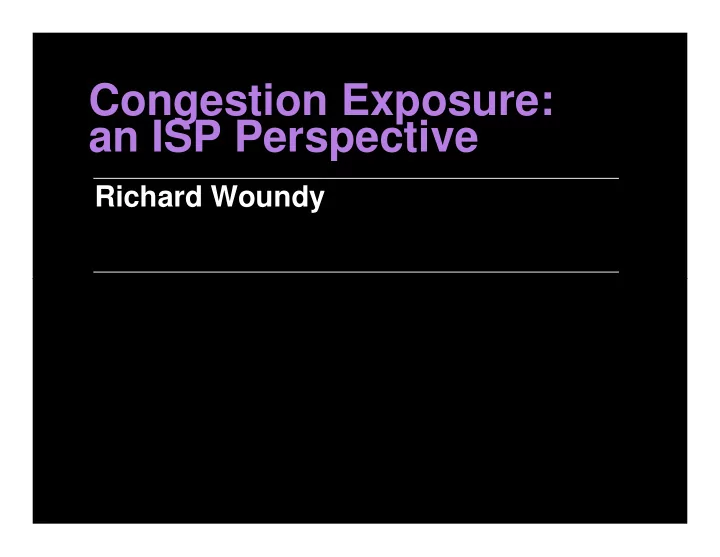

Congestion Exposure: an ISP Perspective Richard Woundy
ISP Motivations for Congestion Management ISP must be responsive to dissimilar customer application demands • Customer care call volume is an obvious indicator of customer dissatisfaction, as well as its own support cost • Mix of popular customer applications tends to vary according to demographics, e.g., higher P2P usage in college environments • Interactive applications (VoIP, web, streaming video, online gaming) tend to have much stronger diurnal consumption patterns than bulk file distribution (P2P) patterns than bulk file distribution (P2P) ISP must balance multiple external concerns • Internet community, government regulators, different traffic sources & sinks, sustainable business models, etc. Network capacity increases are not instantaneous • DOCSIS bandwidth augmentation usually requires fiber node splits and CMTS port allocations; it sometimes requires new fiber runs, additional CMTS blades and chassis, and occasionally the allocation of additional RF spectrum • Additional access network capacity can be consumed quickly
ISP Requirements for a Long-Term Solution Provide best possible network experience for broadest set of customers Minimize or eliminate cross-customer service quality impacts • Reduce customer care calls • Enable customers to control their own network experience Inform customers of application bandwidth usage and network • reaction to that usage Enable customer-directed prioritization of application bandwidth • usage Enable continued Internet evolution Avoid ‘cat and mouse game’ with the detection and mitigation of • specific protocols Enable transparency of network operation for current and future • applications Support a reasonable network capacity upgrade schedule Support growth in number of customers • Support growth in per-customer average and peak bandwidth • Avoid uneconomic capacity upgrades that benefit only 5% of heavy • usage customers
FCC “Open Internet” Notice of Proposed Rulemaking “Subject to reasonable network management, a provider of broadband Internet access service may not: 1) prevent any of its users from sending or receiving the lawful content of the user’s choice over the Internet; 2) prevent any of its users from running the lawful applications or 2) prevent any of its users from running the lawful applications or using the lawful services of the user’s choice; 3) prevent any of its users from connecting to and using on its network the user’s choice of lawful devices that do not harm the network; or 4) deprive any of its users of the user’s entitlement to competition among network providers, application providers, service providers, and content providers.”
FCC “Open Internet” Notice of Proposed Rulemaking (continued) “The draft nondiscrimination principle would require that, subject to reasonable network management, a provider of broadband Internet access service must treat lawful content, applications, and services in a nondiscriminatory manner. The draft transparency principle would require that, subject to The draft transparency principle would require that, subject to reasonable network management, a provider of broadband Internet access service must disclose such information concerning network management and other practices as is reasonably required for users and content, application, and service providers to enjoy the protections specified in this rulemaking.”
Overview of Comcast Congestion Management Concepts behind Comcast congestion management • Goal: consistent performance of Internet applications even with heavy traffic, e.g., from P2P file sharing • Both “protocol agnostic” and “application agnostic” • Acts on current network conditions and recent user traffic • Compatible with Internet standards and supportive of Internet innovation Congestion management details • Use two different Quality of Service (QoS) levels for best • Use two different Quality of Service (QoS) levels for best effort traffic over DOCSIS network – Priority Best Effort (PBE), which is the default QoS – Best Effort (BE) • Customer traffic in congestion-managed state is forwarded with a lower priority (BE) • Upstream and downstream DOCSIS networks are managed separately • Only impact the traffic of users marked with BE QoS when congestion actually occurs Very few customers (< 1%) impacted by congestion management
Comparison of Comcast Mechanism and Conex Similarities • “Protocol agnostic” and “application agnostic” • Acts on current network conditions and recent user traffic • Compatible with Internet standards and supportive of Internet innovation • Can be incrementally deployed in production networks Differences Differences • Conex enables end-to-end congestion management • Conex signals the presence of congestion to user applications and to all devices on the network path • Conex enables additional user and/or application responses to congestion • Conex enables DDoS mitigation and other capabilities • Comcast mechanism has been deployed in production nets • Comcast mechanism does not require changes to hosts
Conclusions An ISP congestion management mechanism must be responsive to dissimilar customer application demands, but also balance multiple external concerns. Internet capacity sharing solutions (such as Conex) can benefit from the recent Comcast experience with congestion management. Conex is a potential solution for end-to-end congestion management.
Recommend
More recommend